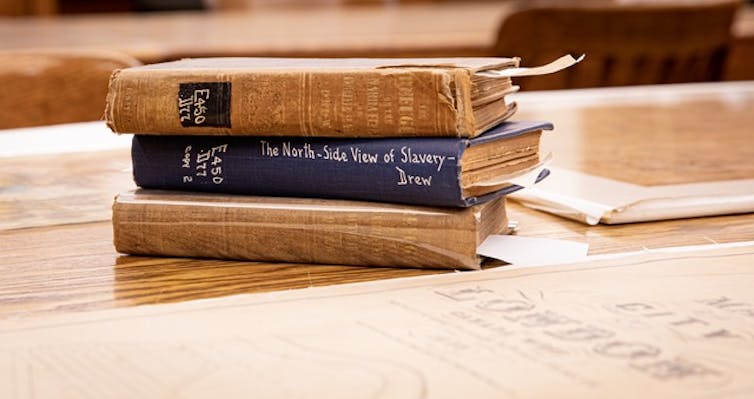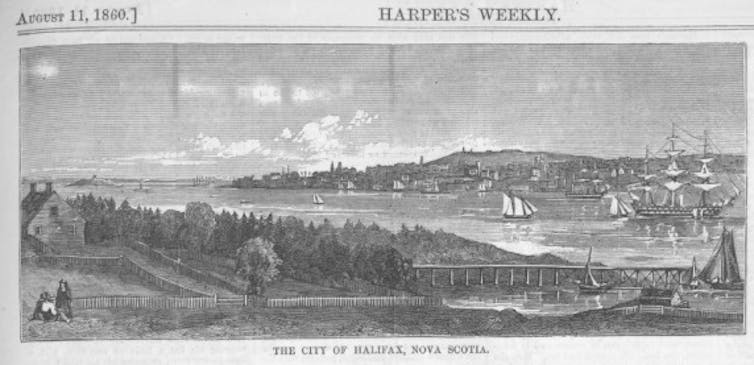Aurelia Jones was a prominent member of the Black community in mid-19th century London, Ontario, Canada, and the spouse of Abel Bedford Jones, a Black entrepreneur and religious and political leader.
After A.B.’s death, Aurelia moved to Halifax, Nova Scotia. The archival traces of her life tell the story of a migration from one Black community with British and American affiliations to another with strong Caribbean influences.
As research associates on the Black Londoners Project at Western University, we are finding historical clues about people like Aurelia Jones and exploring the Black history of London, Ont., by using a digital mapping approach. This methodology helps to understand the movements of individual people and how these movements, in turn, reveal connections within communities and to other places.
Black migration to and from Canada is an ongoing process dating back to the 17th century. The migrations of Black individuals often reflect the geographic and cultural connections of Black communities across borders and further into the African diaspora.
(‘Provincial Freeman’/INK – ODW Newspaper Collection). , Author provided (no reuse)
Black geographies, Canadian myths
Scholars such as Katherine McKittrick, professor and Canada research chair in Black Studies, have highlighted how understanding Black history means being attentive to how geography, culture and race intersect in the formation of Black communities.
Such considerations challenge persistent myths of Canada’s past. For example, Black Canadian historian Barrington Walker has argued there is a “deep psychic and emotional attachment to the idea of Canada as a refuge and a haven from U.S. slavery and racial injustice.”
The promise of freedom on British soil creates a moral binary between the United States and Canada that obscures the history of slavery in Canada.
Further, the idea that African American refugees uniformly would become loyal British subjects misrepresents the enduring connections between Black Canadians and other parts of the African diaspora.
Meet the Black snowshoers who walked 1,000 kilometres across Canada in 1813
Shifting the focus from nationalist discourse to migrations among Black communities helps us better understand everyday Black life.
Digital Black history projects
The Black Londoners Project approaches Black history geographically by supplementing the narratives of 16 Black refugees from slavery and racial oppression in the U.S. with archival evidence (among others, personal narratives, census information and newspaper articles) of their lives in London, Ont.
The project aims to form a map of Black spaces in London, and to trace the connection diverse African diasporas have to the city. Digital tools then visualize how Black communities shaped each other and Canadian society at large.
Users of our online site will be able to read biographical entries with digitized archival materials and to browse digital maps of Black historical sites in London. The website will also connect with other digital Black Canadian History projects:
- A Black People’s History of Canada aims to address and rectify the absences of Black Canadian history in school curricula. The project is headed by Afua Cooper, professor in the department of sociology and social anthropology at Dalhousie University;
Black oral history, digital mapping
Digital mapping of Black migrations allows us to centre Black historical presence in public memory and examine Black oral narratives outside of their abolitionist framing. The teacher and white abolitionist, Benjamin Drew, published narratives of Black refugees in Ontario in his 1856 anti-slavery report, The Refugee; or, A North-Side View of Slavery. A primary narrative of A.B. Jones comes from Drew’s report.
A.B. Jones told Drew about his desires for liberty in Canada, stating: “I wished then to emigrate to some place where I could be really a FREE MAN … therefore, I came here, and am only sorry to say that I did not come years before I did.” The passing of the Fugitive Slave Act in 1850 in the U.S. led to much Black migration across the border.

(Chris Kindratsky/Western Communications at Western University)., Author provided (no reuse)
However, the attitude of many Black Canadians toward the potential of equality in Canada would change after the 1850s as, for example, access to education became increasingly segregated.
Many would move within Canada, to the U.S. and other places in search of support from and community with the African diaspora.
Aurelia Jones
Through A. B. Jones’s account, we learned of his spouse, Aurelia Jones (née Bonsor), in the marriage register of Upper Canada/Canada West. Following A. B.’s death around 1860, there are few records of Aurelia living in London.
Aurelia’s case shows how peripheral Black women are in the archive. In the words of African American Studies professor Ula Taylor, “the clues to their experiences are limited, heavily tainted, or virtually nonexistent.” A public record of Aurelia exists because of her husband: after she inherited his property, she appears as “Mrs. A.B. Jones” in tax records.
However, Aurelia reappears in Hutchinson’s Nova Scotia Directory of 1867 and in the 1881 Canada census for Nova Scotia, living in Halifax. There, Aurelia lived on Creighton Street with a Black couple from Antigua and Jamaica.

(HathiTrust)
Nova Scotia’s Black communities emerged from layers of migration; for example, Black Loyalists arrived during the American Revolutionary War (1775-83), and African Caribbean peoples came looking for work in the 19th and 20th centuries. Creighton Street was a centre of Black Haligonian life well into the 20th century.
Migrations, diasporic connections
As researchers, we explore circumstances behind Aurelia’s migration to Halifax.
What potential factors led her to leave London? How did she meet her Halifax roommates? Had she established a social network with Black peoples from inside and outside Canada? These questions have remained unanswered because of her erasure and the lack of historical documentation on the lives of Black Canadian women from the 19th century.
Tracing out these intersections of Black communities leads us to visualize history in a way that acknowledges, in the words of Africana and American studies professor Rinaldo Walcott, how Black people “redraw and rechart the places/spaces that they occupy.”
The Black documentary filmmaker Dawn Porter recently called for the need to expand public awareness of Black history beyond the shortest month of the year. We recognize the irony in writing this piece during Black History Month.
For Black communities as well as activists and scholars, remembering Black history happens every day of the year. Visualizing Black geography asks us to think of more permanent, transnational ways of commemorating Black history and honouring lives like that of Aurelia Jones.




